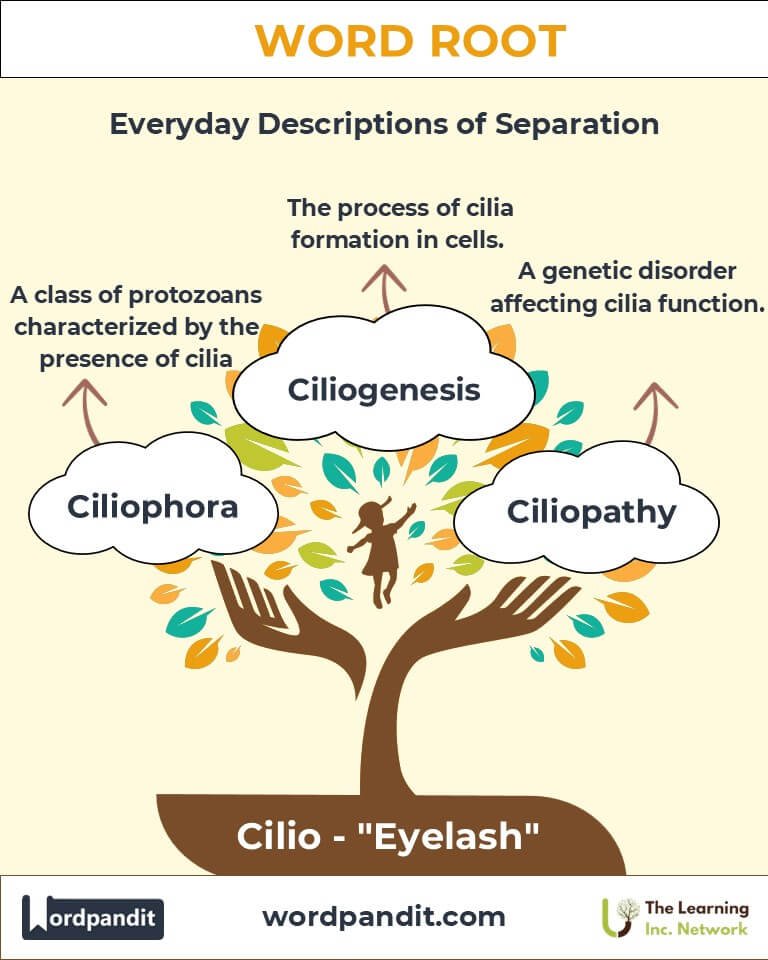Cilio: The Lash of Science and Nature
Dive into the world of the root "Cilio," derived from Latin, meaning "eyelash." Explore its connections to biology and language, from cellular structures like cilia to fascinating organisms like ciliates, showcasing its versatility in describing motion, sensation, and life.

Table of Contents
- Introduction: The Lash of Cilio
- Etymology and Historical Journey
- Mnemonic: Unlocking the Power of Cilio
- Common Cilio-Related Terms
- Cilio Through Time
- Cilio in Specialized Fields
- Illustrative Story: Cilio in Action
- Cultural Significance of Cilio
- The Cilio Family Tree
- FAQs about the Cilio Word Root
- Test Your Knowledge: Cilio Mastery Quiz
- Conclusion: The Flickering Legacy of Cilio
1. Introduction: The Lash of Cilio
What connects the microscopic motion of a cell to the gentle flicker of an eyelash? The root "Cilio," derived from the Latin "cilium" (eyelash), provides a linguistic bridge between the visible and microscopic worlds. Its influence extends to biology, describing hair-like structures (cilia) that drive essential processes in living organisms, and to broader language, where it denotes sensitivity and fine-tuned motion.

2. Etymology and Historical Journey
The word root "Cilio" stems from Latin cilium, meaning "eyelash." Ancient Roman scholars noted the resemblance between eyelashes and the microscopic, hair-like structures seen in nature. With the advent of modern science, the term gained prominence in biology, specifically in cellular anatomy, where "cilia" describe tiny projections responsible for movement and sensory input.
3. Mnemonic: Unlocking the Power of Cilio
Imagine a single eyelash gently brushing a surface, symbolizing both the microscopic motion of cilia and the delicate touch of eyelashes.
Mnemonic Device: "Cilio sweeps and senses, from lashes to cells."
4. Common Cilio-Related Terms
- Cilium (SIL-ee-um): A hair-like projection on cells that helps in movement or sensing.
Example: "Cilia in the lungs help clear out debris and mucus." - Ciliate (SIL-ee-ayt): A type of single-celled organism with cilia for movement.
Example: "Ciliates thrive in aquatic environments, using cilia to swim." - Supercilium (soo-per-SIL-ee-um): The arch of hair above the eye, also known as the eyebrow.
Example: "The supercilium accentuates facial expressions." - Microcilia (my-kroh-SIL-ee-uh): Extremely small cilia found on certain cell surfaces.
Example: "Microcilia in the inner ear detect sound waves." - Deciliation (dee-sil-ee-AY-shun): The removal or loss of cilia.
Example: "Researchers study deciliation to understand respiratory diseases."
5. Cilio Through Time
- Classical Origins: In ancient Rome, "cilium" referred to eyelashes and their elegant movements, symbolizing sensitivity and grace.
- Modern Science: The discovery of cellular cilia in the 17th century expanded the root's significance, highlighting its vital role in locomotion and sensory functions.
6. Cilio in Specialized Fields
- Biology: Cilia in the respiratory tract help expel mucus and particles, essential for lung health.
- Medicine: Ciliopathies (genetic disorders affecting cilia function) can lead to conditions like polycystic kidney disease.
- Microbiology: Ciliates, such as Paramecium, use cilia for movement and play a crucial role in aquatic ecosystems.
- Anatomy: Supercilia (eyebrows) protect the eyes from sweat and debris while enhancing non-verbal communication.
7. Illustrative Story: Cilio in Action
Dr. Mira Patel, a microbiologist, studied cilia's role in respiratory health. During a severe flu outbreak, she discovered that patients with reduced cilia activity were at higher risk of complications. Her research led to therapies that boosted cilia regeneration, improving recovery rates and showcasing the life-saving importance of these microscopic structures.
8. Cultural Significance of Cilio
Beyond science, "cilio" symbolizes sensitivity and precision. Eyelashes, for example, have inspired poetic imagery, while their protective function underscores themes of care and resilience. In many cultures, eyelashes are associated with beauty and expressions of emotion, making them a bridge between biology and human experience.

9. The Cilio Family Tree
- Pilo- (Latin: "hair"): Pilosity (hairiness) and pilose (covered in soft hairs).
- Tricho- (Greek: "hair"): Trichology (study of hair disorders) and trichome (hair-like structures on plants).
- Flocc- (Latin: "tuft of wool"): Flocculent (having a fluffy appearance) and flocculus (a tuft-like structure).
10.FAQs About the Cilio Word Root
Q1: What does "cilio" mean?
A: The root "cilio" comes from the Latin word cilium, meaning "eyelash." In biological contexts, it refers to fine, hair-like structures called cilia that perform movement or sensory functions in cells. This dual meaning connects the visible elegance of eyelashes with the microscopic utility of cilia.
Q2: What are cilia?
A: Cilia are microscopic, hair-like projections found on the surface of certain cells. They perform essential tasks, such as clearing debris in the respiratory tract or aiding movement in single-celled organisms. These structures are critical for maintaining health and facilitating cellular functions.
Q3: What is a ciliate?
A: A ciliate is a single-celled organism, like Paramecium, that uses cilia for locomotion and feeding. These organisms are often found in aquatic environments and play a key role in ecosystems by consuming bacteria and other microorganisms.
Q4: How do cilia function in humans?
A: In humans, cilia are found in the respiratory tract, where they move mucus and trapped particles out of the airways, helping to keep the lungs clear. In the reproductive system, cilia in the fallopian tubes aid in moving eggs toward the uterus. Their functions are vital for overall health and efficiency in many bodily systems.
Q5: What is a ciliopathy?
A: A ciliopathy is a genetic disorder caused by defects in the structure or function of cilia. These disorders can lead to conditions like polycystic kidney disease or respiratory problems due to impaired ciliary movement. Research into ciliopathies aims to improve treatments for these often-complex diseases.
Q6: How are eyelashes related to cilia?
A: Both eyelashes and cellular cilia share a connection in their root word cilium. Eyelashes protect the eyes by blocking dust and debris, while cilia serve a similar protective and functional role at the cellular level, emphasizing their shared importance in safeguarding and maintaining systems.
Q7: What is deciliation, and why is it significant?
A: Deciliation is the process of losing or removing cilia, either naturally or experimentally. It can occur due to diseases, environmental factors, or in laboratory settings to study ciliary functions. Understanding deciliation helps researchers explore treatments for conditions where ciliary activity is impaired.
11.Test Your Knowledge: Cilio Word Root Quiz
1. What does the root "cilio" mean?
2. What do cilia do in the lungs?
3. What are ciliates?
4. What is deciliation?
5. What does "supercilium" refer to?

12. Conclusion: The Flickering Legacy of Cilio
The root "cilio" bridges the macroscopic and microscopic worlds, embodying elegance and function. From eyelashes to cilia, it highlights the beauty and utility of fine-tuned motion. As science advances, the study of "cilio" continues to reveal its vital role in health and ecology, underscoring its enduring significance in our understanding of life.











